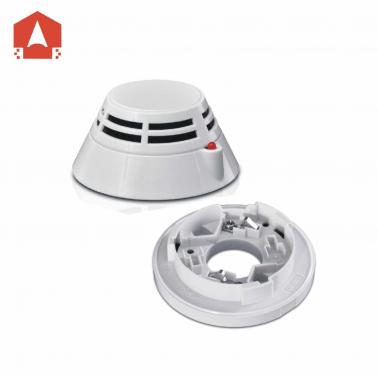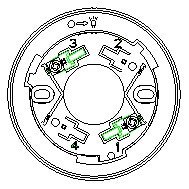Products Intelligent Fire Alarm System Addessable Detectors Details
DetailsAddressable Smoke Detector:CFT-930
I. Product overview
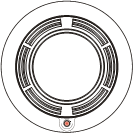
CFT-930 Addressablesmoke detector (Detector hereunder) is a kind of photoelectric smoke detector. Withan internal microprocessor, it supports electronic coding and is accessed through a compatible fire alarm control panelof CFT-MN300 via a two-wire bus. The detector realizes real-time acquisition of the in situ smoke concentration data andsends back the data to a fire alarm control panel. It can also receive andexecute the control commands given by a fire alarm control panel.
The detector is suitable for such industrial and civilbuildings that have a great deal of smoke during fires but no smoke undernormal circumstances, such as restaurants, hotels, teaching buildings, officebuildings, computer rooms, communication machine rooms, libraries and archives.It is not suitable for places with agreat deal of retained dust and water mist, places where steam and/or oil mistmay be generated and places with retained smoke under normal circumstances.
II. Product features
* It can realize electronic coding and rewritethe address via coder in situ.
* Within a single-chip microcomputer, it can process thesampling data in real-time, save the latest 144 historical data and realize acurve tracing for the field situation.
* It has a temperature, humidity and dust accumulation driftcompensation function and a sensor fault detection function (fault reporting tofire alarm control panel).
* Non-polarity, two-bus connection that ensuresconvenient installation and maintenance.
* Designed with an upper cover and a lower cover and installedon an independent base, it can be installed, debugged and maintained conveniently.
III. Technical parameters
1. Executive standard: GB4715-2005
2. Operating voltage: 24V (pulse modulation)
3. Operating current: <300uA(monitoring status) or <1.5mA(alarm status)
4. Work indication: The red indicator will blink in themonitoring status or remain lit in the alarm status.
5. Weight: about 70g
6. Externaldimensions: diameter: 100mm,height: 55mm (withthe base)
7. Wiring method: non-polaritytwo-bus system (L1, L2)
8. Operating environment: Indoor, temperature: -10℃~+55℃;relative humidity: ≤95% (40℃±2℃, withoutcondensation)
9. Coding mode: It can realizeelectronic coding via coder in situ. Address codes 1 to 324 are available forselection.
10. Installation height: ≤12m
11. Protection area: about 60m2. For details, see related provisions inGB50116-98 Code for Design of AutomaticFire Alarm System
12. Matched host machine:fire alarm control panel (such as CFT-MN300)
IV. Appearance and dimensions (see Fig.1)
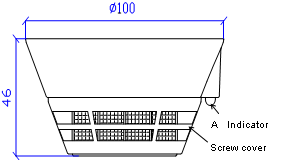
Fig.1
V. Use and engineering application
1. Fig.2 is the schematic diagram of thematched mounting base.
Fig.2 | Definitions of terminals(non-polarity two-wire system): 1 --Signal terminal (L1) 2 –No Pin 3 --Signal terminal (L2) 4 –No Pin |
2. Wiring method: The detector is accessed through a compatible fire alarm control panelvia a two-wire bus. It uses non-polarity connection. The terminals L1 and L2 ofthe two-wire bus are connected with the terminals 1 and 3 of the matchedmounting base. Fig.3 is a schematic diagram of the connection between multipledetectors with a fire alarm control panel.

Fig.3
3. Codingaddress: As shown in Fig.4, detector is accessed via the detector mounting baseon the coder, non-polarity connection is adopted for the terminals L1 and L2,set the coder with the coding function, select the correct address number andpress the RUN key to complete the address code setup. (Note: See the User’sManual of the coder for the detailed operation.)
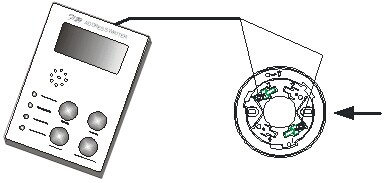
Fig.4
VI. Installation and debugging
Determine thelocation, mounting distance and numbers for mounting the detectors in theprotection area according to relevant provisions and regulations of GB50116-98 Code for Design of Automatic Fire AlarmSystem and GB50166-2007 Code forInstallation and Acceptance of Fire Alarm System.
A self-contained complete base is necessary during theinstallation of a detector. As shown in Fig.5, the model, the externaldimensions, the mounting hole diameter and the mounting hole spacing of thebase are DZ-910, 100mm×22mm (diameter×thickness), 5mm and 56mm~64mmrespectively.
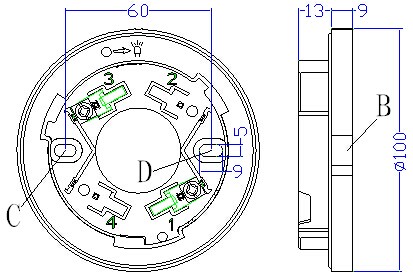
Fig.5
Wiring requirement:
It isproper to use RVS twisted pairs with a section area of equal to or larger than 1.0mm2 for the signal buses L1 andL2.
Specific installation and debuggingmethods:
1. Makesure the type of the detector matches the type of the host machine of the firealarm control panel;
2. Usetwo M4 screws to fix the matched mounting base on the designated position viathe mounting holes C and D shown in Fig.5, as instructed in the constructiondrawing and make sure the matched mounting base has been firmly installed.
3. Usea coder to make the detector coded according to the detector address on theconstruction drawing.
4. Disconnectthe power supply of the fire alarm control panel and connect the detectorcorrectly according to the construction drawing.
5. Placethe indicator at position A of the detector (see Fig.1) and position B of thebase (see Fig.5), align them with each other, insert the detector into the baseand turn the detector clockwise until it is firmlylocked.
6. Afterall the products are installed and checked, connect the power supply of the firealarm control panel and conduct automatic login.
7. Whenautomatic login is success, the red indicator of the detector will blink onceabout every 12 seconds, which suggests that the detector has begun to operatenormally.
8. Finallyconduct an alarm test for the detector through some special tools or directsmoke blowing. After the detector gives a fire alarm, the indicator will remainlit and the fire alarm control panel will simultaneously show correspondingalarm prompt information. After the alarm test, reset the fire alarm controlpanel and restore to the monitoring status.
VII. Precautions
1. Adetector can not share an address with other equipment in a single bus circuit,or else an address conflict may occur.
2. Neverdismount the protective cover delivered with the detector too early after thefield installation and before the use of the detector, or else the detector maybe contaminated.
3. The protection area andquantity of the detectors should comply with relevant provisions in GB50116-98 Code for Design of Automatic Fire AlarmSystem and GB50166-2007 Code forInstallation and Acceptance of Fire Alarm System.
VIII. Maintenance
Warning: Before conducting maintenancefor detectors, informtherelated management department that the monitoring will be stopped temporarilywhen the system maintenance. Meanwhile, disable the logic control function ofthe area or system to be maintained to avoid unnecessary alarm linkage. Afterthe test, inform the management department to restore the normal functions ofthe system.
1. For adetector, at least semi-annual tests should be done according to relatedprovisions of GB50166-2007 Code forInstallation and Acceptance of Fire Alarm System; for a detector that hasbeen installed and used, it is recommended to haveit cleaned and maintained once every two years.
2. Operatingenvironment has a great influence on the performance of the detector. If thedetector is installed and used in a placewhere its normal use is easily affectedby dust, high wind speed and other factors, its maintenance period should beshortened.
3. If adetector fails due to a material defect or a manufacturing process defect undernormal conditions of use in one year following the date of its delivery, weshall repair or replace it for free. However, the faults of the detector due toartificial damage, improper use, or authorizedadjustment, reconstruction or disassembly are not coveredin the guaranteeand we shall assume no responsibilities for any theconsequence thereby caused.
4. We mayprovide paid repair service for products with any faults beyond the guaranteerange. If you have such products that need repair,please contact us. When sending such a product to us for repair, you areexpected to provide some important information about the product, such as thephenomenon and possible cause of the product fault, so that we can find out thecause of the fault in the shortest time and so theinformation may be used as a reference in our future product development andimprovement.
IX. Fault analysis and troubleshooting
Fault | Possible cause | Troubleshooting method | Remarks |
The detector can’t be coded. | The internal circuit is damaged. | Send the detector back to the factory for repair. |
|
The detector can’t be logged into normally. | The detector has no address or has a coincident address. | Recode the detector address. |
|
The detector reports a fault after login. | The sensor has failed. | Send the detector back to the factory for repair. |
|
The labyrinth is seriously contaminated. | Clean the labyrinth of the detector. |
| |
The detector reports a fire alarm after login. | There is a great deal of smoke dust or steam in the room. | Log in again after the smoke, dust or the steam is eliminated. |
|
The internal circuit has failed. | Send the detector back to the factory for repair. |
| |
The labyrinth is seriously contaminated. | Clean the labyrinth of the detector. |
| |
The detector cannot operate normally after being powered up. | The indicator or the internal circuit is damaged. | Send the detector back to the factory for repair. |
|
The contact with the base is poor. | Inspect and reinstall the base. |
| |
The detector can’t send out fire alarm signal during an alarm test. | The internal circuit is damaged. | Send the detector back to the factory for repair. |
|


